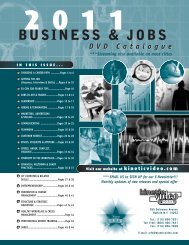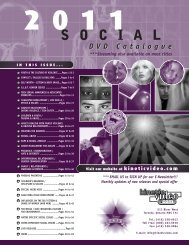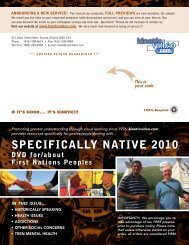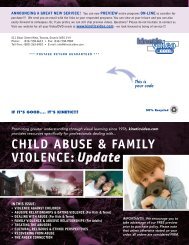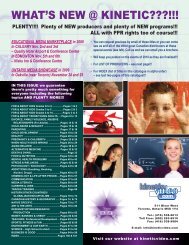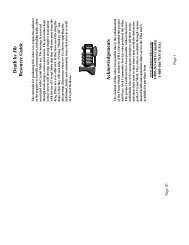WHAT'S NEW @ KINETIC???!!! - Kinetic Video
WHAT'S NEW @ KINETIC???!!! - Kinetic Video
WHAT'S NEW @ KINETIC???!!! - Kinetic Video
You also want an ePaper? Increase the reach of your titles
YUMPU automatically turns print PDFs into web optimized ePapers that Google loves.
MAKING CONFLICT POSITIVE<br />
Conflict is inevitable, but it does not have to be negative.<br />
Conflict arises for various reasons and, if approached<br />
appropriately, can be a learning situation. This program<br />
defines conflict, discusses responses to conflict, and<br />
differentiates between aggression and assertiveness.<br />
#12992 30 minutes 2007 $379.95<br />
LISTENING<br />
Differentiating between listening and hearing, this<br />
program examines different types of listening including<br />
discriminative, comprehensive, critical-evaluative,<br />
therapeutic, and appreciative forms, and looks at the<br />
elements of the listening process. The program also<br />
considers barriers to effective listening.<br />
#12874/0880 26 minutes 2008 $259.95<br />
INTERPERSONAL COMMUNICATION AND CONFLICT<br />
In this program, Thomas E. Harkins of New York University examines conflict, outlines the potential benefits of conflict,<br />
presents various definitions for conflict, negates common misconceptions surrounding conflict, discusses sources and patterns<br />
of conflict, and discusses conflict management and prevention. He looks at pragmatic and social constructionist views of<br />
communication and conflict; emphasizes the role of context in determining communication content; and explains how<br />
differences in core beliefs, values, attitudes, habits, and goals can cause conflicts, even when these differences occur on a<br />
subconscious level. The program contrasts constructive and destructive patterns of conflict, outlines the characteristics of<br />
destructive conflict, and presents constructive methods of conflict management. It covers such topics as flexibility,<br />
paralinguistics, avoidance and engagement, styles and tactics of conflict resolution, and the role of egocentrism in conflict.<br />
The DVD features entertaining, illustrative vignettes. #12871/0880 21 minutes 2008 $259.95 *CC<br />
INTERPERSONAL COMMUNICATION WITH PEOPLE OF DIFFERENT AGES<br />
Emphasizing the role of respect in all interpersonal interactions, this program examines communication with individuals of<br />
different ages and considers the ways in which human development affects communication abilities. It outlines the<br />
developmental psychology and life-space perspectives of human development and explains that age groups are social<br />
constructs. The program explores the role of positive and negative stereotypes in age-related communication, outlines the<br />
natural reasons individual create and use stereotypes, shows how stereotypes provide categories that offer cues for<br />
appropriate behavior, discusses the limits of stereotypes, and teaches how to employ stereotypes and the recognition of their<br />
existence to treat people of all ages as unique individuals. The program also offers skills and techniques for communicating<br />
with individuals of different ages and provides specific guidelines for modifying communication to enhance interpersonal<br />
interactions with infants, toddlers, adolescents, and older adults. #12875/0880 22 minutes 2008 $259.95 *CC<br />
PRINCIPLES OF INTERPERSONAL COMMUNICATION<br />
In this program, Karina Alexanyan of Columbia University outlines the functions of interpersonal communication,<br />
instrumental, prevention, phatic, affective, and deceptive forms; introduces the theory behind interpersonal communication;<br />
and teaches how to increase the effectiveness of interpersonal interactions. Explaining that communication cannot be<br />
separated from context and that context can be as important to communication as the words spoken, Alexanyan explores the<br />
variables that define context, including situation, style, function, participants, body language, and conscious and unconscious<br />
assumptions and intentions. She considers the influences of group affiliation and diversity on interpersonal interactions;<br />
discusses such facets of nonverbal communication as body language, personal appearance, proxemics, paralanguage, haptics,<br />
and chronemics; examines listening and offers tips to improve listening effectiveness; and covers such interpersonal skills as<br />
relating, conflict management, responding to self-disclosure, giving and receiving feedback, and enhancing communication<br />
with individuals from diverse backgrounds. The DVD includes vignettes that illustrate effective and ineffective interpersonal<br />
interactions. #12873/0880 25 minutes 2008 $259.95 *CC<br />
BODY LANGUAGE SERIES<br />
Some of your students may be bilingual and some may have taken a course in Spanish, Latin, or Japanese. But are any of<br />
them fluent in Kinesics? Kinesics is the study of body language as a form of communication. When we read a billboard, its<br />
message is usually larger than life and quite clear. Is it possible to read people's thoughts and feelings just by looking at<br />
them? Well, we can get pretty close if we learn to identify the silent signals they send. These two programs go “beyond<br />
words” and help us “read people”.<br />
BODY LANGUAGE I: Beyond Words - People engaged in a conversation may exchange 200 words per minute, but more than<br />
half of their communication is nonverbal. We often use gestures, postures and eye contact without thinking twice about<br />
them, but these behaviors can communicate so much beyond the words that we use. The way we treat our personal space<br />
and that of others can send a message that is loud and clear, even if we never speak a word. This program is an informative<br />
look into the fascinating world of nonverbal communication and guides viewers through the land of space wars, tongue<br />
showing, mirrored postures and the many layers that make up unspoken communication.<br />
BODY LANGUAGE II: Reading People<br />
We send signals all the time and may not even be aware of it. Gestures we use and faces we make send signals. The volume,<br />
speed and inflections of our voices communicate in ways that we many not intend. Through the study of emblems,<br />
illustrators, affect displays and eye behavior, a student of body language can gain insight to what people express beyond the<br />
words that they use. When people do use words, students can learn to identify and interpret paralanguage. This program<br />
provides valuable information about interpreting body language by presenting fun, easy to understand and real life examples.<br />
If your students apply this information and do some intelligent people watching, they'll see a whole new world of<br />
communication they may never have noticed.<br />
#11785/1120 Two 22-minute programs 2008 *Includes Guides $125.95 each or Series $229.95 *CC<br />
59






